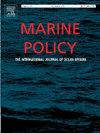Impacts of a community-based TURF-Reserve policy on CPUE and fishers’ income: Evidence from a spatial fuzzy regression discontinuity design
IF 3.7
2区 社会学
Q2 ENVIRONMENTAL STUDIES
引用次数: 0
Abstract
The Territorial Use Rights for Fishing with Reserve (TURF-Reserve) is a promising coastal resource management policy in the Philippines, designed to sustain marine resources and alleviate poverty in coastal communities. It features behavioral change campaigns, conservation, harvest regulation, and institutional development. With the increasing use of quasi-experimental methods in impact evaluations and their limited application to conservation efforts, this study is novel as it pioneers the application of Spatial Fuzzy Regression Design in the context of TURF-Reserve assessment in the 4th District of Camarines Sur. The analysis focused on the policy’s impact on catch per unit effort (CPUE) and the monthly income of municipal capture fishers. The evaluation identified the eligible population and defined the treatment and control areas based on estimated spillover effects and territorial water legislation. Using Two-Stage Least Squares, the study found that the TURF-Reserve policy increased CPUE of fishers by 11.45 kg/km². These findings suggest that the TURF-Reserve delivers more substantial environmental than economic benefits, primarily by supporting resource sustainability and enhancing food security in the intervention community. This is consistent with broader evidence on the effectiveness of conservation programs. Furthermore, the study affirms that the TURF-Reserve approach is well-suited to Philippine coastal communities. However, the findings are constrained by the study’s limited geographical scope and small sample size. To strengthen the robustness and generalizability of the results, future research should replicate the study across multiple TURF-Reserve sites, cover broader geographical areas with larger samples, and include direct measurement of the spillover effect.
基于社区的草皮保护政策对CPUE和渔民收入的影响:来自空间模糊回归不连续设计的证据
“保留区渔业领土使用权”(TURF-Reserve)是菲律宾一项很有前途的沿海资源管理政策,旨在维持海洋资源和减轻沿海社区的贫困。它以行为改变运动、保护、收获监管和制度发展为特色。随着准实验方法在影响评价中的应用越来越多,其在保护工作中的应用有限,本研究开创性地将空间模糊回归设计应用于南卡马内斯第四区草皮保护区评价。分析的重点是该政策对单位努力渔获量(CPUE)和城市捕捞渔民月收入的影响。评估确定了符合条件的人口,并根据估计的溢出效应和领土水立法确定了处理和控制区域。利用两阶段最小二乘法,研究发现,草皮保护区政策使渔民的CPUE增加了11.45 kg/km²。这些发现表明,草皮保护区带来的环境效益大于经济效益,主要是通过支持资源可持续性和加强干预社区的粮食安全。这与更广泛的关于保护项目有效性的证据是一致的。此外,该研究证实,草皮保护区方法非常适合菲律宾沿海社区。然而,这项研究的地理范围有限,样本量小,研究结果受到了限制。为了加强研究结果的稳健性和可推广性,未来的研究应在多个草皮保护区重复研究,覆盖更广泛的地理区域和更大的样本,并包括对溢出效应的直接测量。
本文章由计算机程序翻译,如有差异,请以英文原文为准。
求助全文
约1分钟内获得全文
求助全文
来源期刊

Marine Policy
Multiple-
CiteScore
7.60
自引率
13.20%
发文量
428
期刊介绍:
Marine Policy is the leading journal of ocean policy studies. It offers researchers, analysts and policy makers a unique combination of analyses in the principal social science disciplines relevant to the formulation of marine policy. Major articles are contributed by specialists in marine affairs, including marine economists and marine resource managers, political scientists, marine scientists, international lawyers, geographers and anthropologists. Drawing on their expertise and research, the journal covers: international, regional and national marine policies; institutional arrangements for the management and regulation of marine activities, including fisheries and shipping; conflict resolution; marine pollution and environment; conservation and use of marine resources. Regular features of Marine Policy include research reports, conference reports and reports on current developments to keep readers up-to-date with the latest developments and research in ocean affairs.
 求助内容:
求助内容: 应助结果提醒方式:
应助结果提醒方式:


